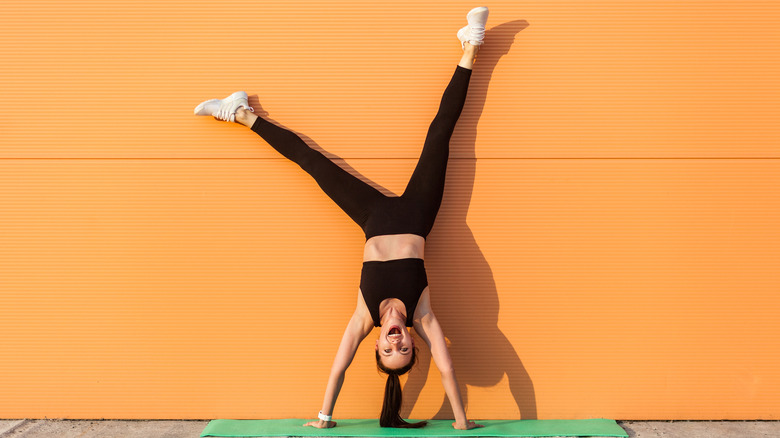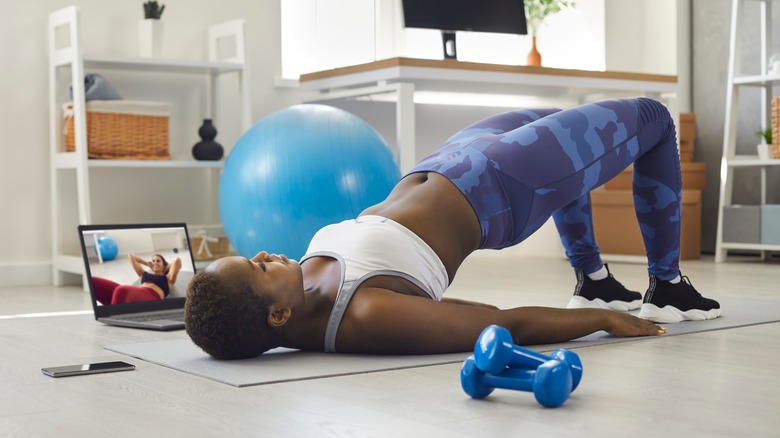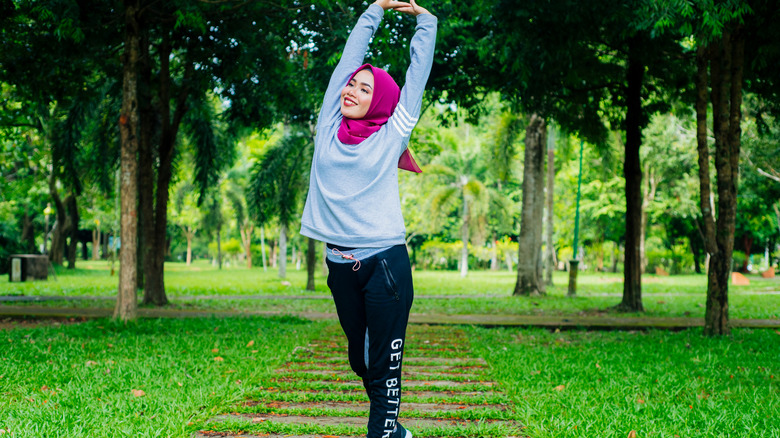The TikTok Viral Handstand Challenge Is Harder Than You Think
If you're an avid TikTok user, you've probably come across the viral #wallhandstandchallenge, a challenge in which users place one foot on the ground and the other on a wall or vertical surface before twisting into a handstand and then arching their backs to do a split while upside down, reports Shape. Perhaps unsurprisingly, this trend is as difficult and dangerous as it is confusing to understand. The moves required in the handstand challenge involve advanced skill levels of gymnastics coupled with core strength and flexibility. Novice users, rather than trained acrobats, who have tried this trend have been injured by attempting advanced inversions of their backs and legs, or by falling onto nearby objects after losing their balance.
Since the handstand in the viral challenge can pose a risk of falling, straining a muscle, or even injury, it's important to do the prep work needed prior to attempting any type of handstand (via Shape). Always put safety first, even if the challenge looks really cool or your friends are trying it. Before you attempt the viral handstand challenge, you'll need to focus on building core strength and increasing your flexibility. These two components will help your body prepare for the core stabilization and flexibility required to do a handstand, particularly the one in the TikTok challenge. And regardless of whether your goal is a handstand or simply better health, core strength and flexibility are two components that can make your body all-around healthier, and stronger.
Core strength
Your core is truly at the core of your body's mobility and strength. A strong core can protect you from injury, while increasing your overall stability and balance, according to Mayo Clinic. Think of your core as the lower mid-section of your body, which includes your hips, pelvis, lower back, and, of course, abdominal muscles. When doing exercises to build your core muscles, remember to keep things even. You'll want to strengthen all parts of your core, not just your abs. One recommended exercise to strengthen your pelvis, hips, and lower back along with your core is hip bridges. If you're able, position yourself flat on your back with your feet hip-width apart and knees bent, then slowly lift your hips and pelvis up as high as you can without arching your back or straining yourself. Mayo Clinic advises that traditional core crunches are favorable in building abdominal strength.
Yoga poses can also help you build your core strength, particularly the crow pose, which involves balancing your knees on your arms (per Well+Good). But for safety, always make sure that you're in an open space and won't risk hitting anything if you lose balance. Having someone spot you can also be helpful. The next step of the crow pose is to do crow wrist taps, where you lower your feet to tap your hands (via Well+Good). If those sound too complicated, traditional planks and side planks will definitely build core strength.
Flexibility and mobility
Achieving a handstand requires flexibility and mobility (per Camilla Mia). Doing exercises to build strength and flexibility in your shoulders, arms, and wrists will increase your ability to support your body weight while upside-down. While some may consider mobility and flexibility practically the same, they're different mechanisms of the body, reports Healthline. Mobility is a joint's range of motion, while flexibility is the amount of lengthening a muscle can achieve. To do a handstand like the one in the viral challenge, you'll need to develop both mobility and flexibility. Exercises to increase shoulder mobility include arm swings and weight-based repetitions of reverse flys. For flexibility, try stretching your arms across your body or use a door frame to achieve a deeper stretch. To build hand and wrist strength, try squeezing a tennis ball for five to ten seconds (via Healthline).
Mobility and flexibility are both necessary as flexibility is intrinsically tied to realizing the full range of motion of joints, per Harvard Health Publishing. It's best practice to stretch after you've first completed five to 10 minutes of mild exercise, like a brisk walk, to get oxygen and blood flowing to your muscles. Warming up properly primes your muscles for stretching and increasing flexibility. Stretching cold muscles, including attempting a handstand without first warming up, can increase the risk of injury, per the Massachusetts Institute of Technology. Warming up with joint rotations and slow circular movements, performed clockwise and counterclockwise, can improve mobility by lubricating joints.



